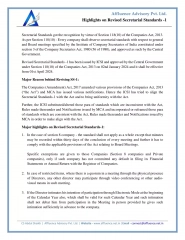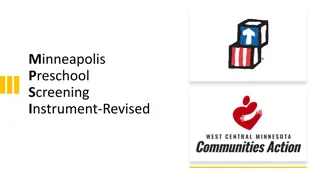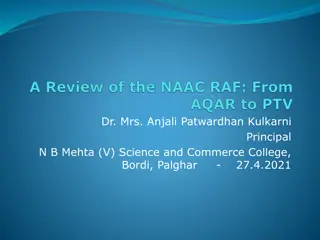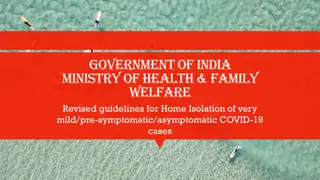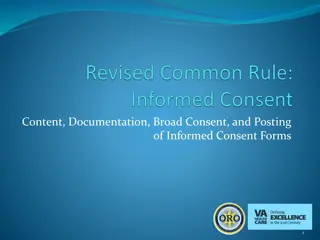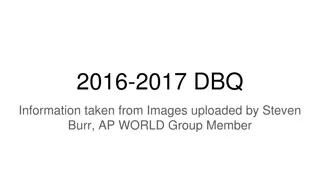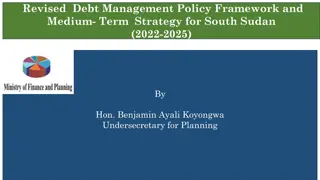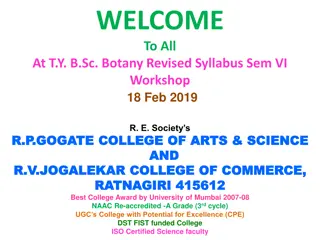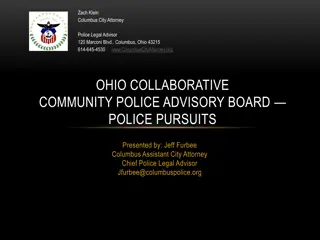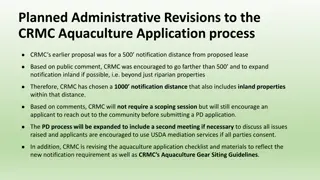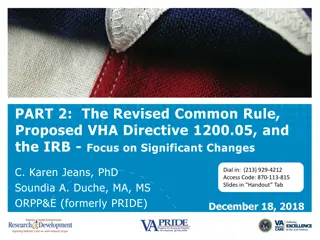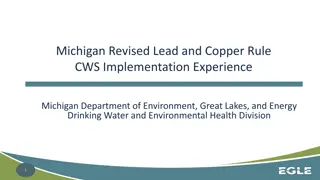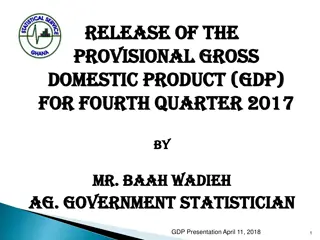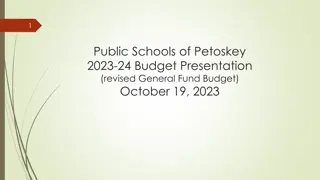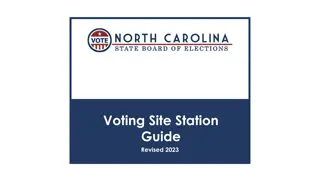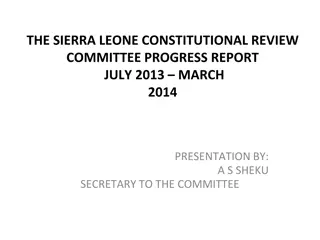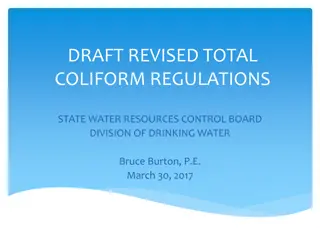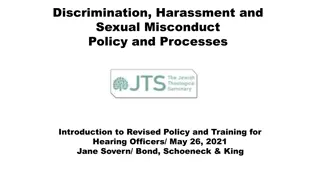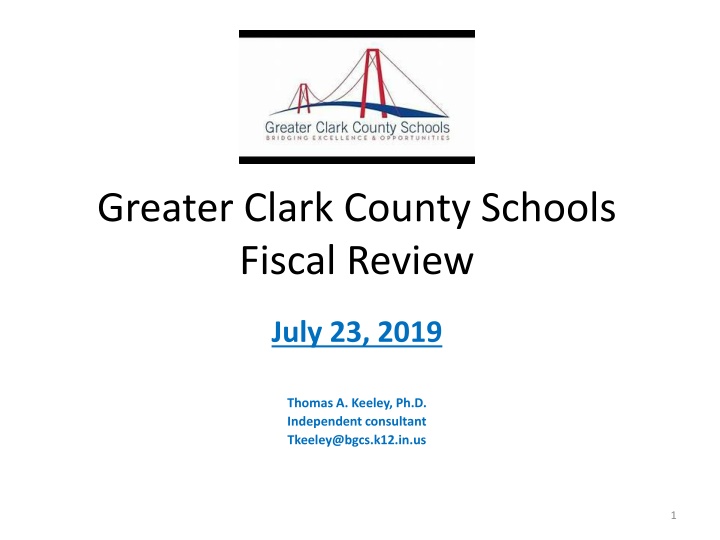
Clark County School Financial Review Process
Gain insights into the Greater Clark County Schools' fiscal review process conducted by independent consultant Thomas A. Keeley, Ph.D. Explore topics such as financial management, budget overview, teacher salaries, insurance, banking services, and more to understand the school's financial health and decision-making strategies.
Download Presentation

Please find below an Image/Link to download the presentation.
The content on the website is provided AS IS for your information and personal use only. It may not be sold, licensed, or shared on other websites without obtaining consent from the author. If you encounter any issues during the download, it is possible that the publisher has removed the file from their server.
You are allowed to download the files provided on this website for personal or commercial use, subject to the condition that they are used lawfully. All files are the property of their respective owners.
The content on the website is provided AS IS for your information and personal use only. It may not be sold, licensed, or shared on other websites without obtaining consent from the author.
E N D
Presentation Transcript
Greater Clark County Schools Fiscal Review July 23, 2019 Thomas A. Keeley, Ph.D. Independent consultant Tkeeley@bgcs.k12.in.us 1
Learning Opportunity Information about this presentation and goals of this review process: Today we will: A. Have an overview of school financial management, terms and important questions that should be asked at every board meeting. This will help the financial team, Superintendent and School Board talk the same language with a knowledgeable approach. P. 1-10 B. Summarize some very complex financial and business information into a format that everyone can understand: 1. Fiscal trend of revenue and expenses for GCCS. P . 1 2. Compare current cash balances and expenses to surrounding area and the State of Indiana. P. 2 3. District performance and student-teacher ratios report. P. 3-6 C. Review cash balance goals and understanding pupil expenditures at each location. 1. Review current enrollment and expenditure report per building data sheet. P. 1 D. Review School Corporation Financial Condition Indicator Dashboards . 1. Office of Fiscal Management and Analysis/Legislative Services Agency P. 1-20 2. How does GCCS compare to others around the State? (See entire tab / Review on your own) E. Consider reporting tools and a monthly School Board Cash Flow Update example. 1. Keep it simple: BGCS Cash Balance Monthly Update. P. 1 2. End of month Skyward cash balance Fund report (page 1). examples: P. 2-4 3. Questions to ask every 6 months/What to look for: Form 9 Financial Report. P. 5-8 4. Example of Annual Budget Presentation format/keep it simple. P. 9-32 2
Learning Opportunity cont. F. Review the current teacher salary schedule and number of teachers at each level. 1. Certified Salary Schedule (In effect June 30, 2018) Teacher count. P. 1-2 2. Article VII Retirement Benefits: 3 observation (Lump Sum Severance, Health and Life insurance). P. 3-5 G. Consider health insurance, life insurance and ancillary insurance (Section 125) 1. Data focused approach with National level carrier comparisons. P. 1-24 2. Making informed decision, value commitment/guaranteed fee structure. P. 25-26 H. Consider Banking Services and the value of an RFP process. 1. The market place for banking services (RFP example) p. 1-4 2. BGCS Business update awards TCU with contract. P. 5-6 3. Other examples of naming rights and the current market place. I. Consider Food Service cash balance history (0800 account) and review management 1. Go to TAB E pages 2-4 to see 0800 annual account balances. 2. Review an RFP to consider guaranteed positive cash flow/sharpens current vendor approach. P. 1-2 3. Chartwells example and partnerships around the state of Indiana. P. 1-2 J. Discuss facilities plans, infrastructure and maintenance. K. Discuss bus replacement outlook and age/inventory of fleet. L. Review 2019 Education Fund and Operations Fund transfer (15% rule) - An article has been provided that illustrates this issue for Indiana public school corporations. P. 1-2 M. Final thoughts, recommendations and Questions Resources: Tab N GCCS Annual Financial Report 2017 Tab O GCCS Master Teacher s Agreement 2017-2019 3
A. OVERVIEW OF SCHOOL FINANCIAL MANAGEMENT Slides 5-14 are a list of all Funds and the Organizational Structure for your public school budget. This may be a review but good information for new school board members. This information will set the stage for our financial review. 4
Budget Funds Education Fund Debt Services Pension Debt Capital Projects Transportation Bus Replacement Operations Fund Referendum Fund Referendum Debt General Fund State Income/Sales Tax (REMOVED for 2019) State Income Tax/Sales Tax Property Tax/Misc. Tax Property Tax/Misc. Tax Property Tax/Misc. Tax (Removed for 2019) Property Tax/Misc. Tax Property Tax/Misc. Tax Property Tax/Misc. Tax Property Tax/Misc. Tax Property Tax/Misc. Tax (Removed for 2019) (Removed for 2019) 5
Education Fund (0101) Budget advertised for $64,292,430 d *derived primarily from State funding
Education Fund Expenses Teacher/Building Salaries Teacher/Building Benefits Property and Causality Insurance Teacher/Building Health Care Insurance School Building Technology School Building Supplies Miscellaneous 7
Education Fund Revenue Tuition SupportStudent Enrollment Sept. 13th/info: Feb. 1st Complexity Grant TANF/SNAP Current Rate Academic Honors Grant $1,000 per Student Special Ed. Grant December 1st Count Day Vocational Ed. Grant$250 to $450 per class Prime Time Grant/KindergartenAdded to Tuition Support Misc. Revenue Part B reimbursement, Summer School, Grants, Other Reimbursements 8
Debt Service Fund (0200) Expenses Payment for long term building debt Interest on long term building debt Textbook/Technology unreimbursed 9
Pension Debt (0250) Expenses Payment for teacher retirement debt Interest on teacher retirement debt 10
Operations Fund (0300) Expenses Technology Maintenance of Technology Building Repairs (Capital Projects type expenses) Utilities (Moved from General Fund) Purchase of Equipment Sports Facilities (5% of total CPF) Transportation Busses 11
Transportation Expenses Operations Fund Bus Driver Salary Bus Driver Benefits Fuel Repair of Buses Miscellaneous Expenses 12
Bus Replacement Expenses Operations Fund Purchase of Buses on 12 year cycle Parts for Buses Security Video for Buses Tires 13
Miscellaneous Tax Revenue License Excise Tax Financial Institution Tax Commercial Vehicle Excise Tax 14
B. GCCS FINANCE AND BUSINESS INFORMATION We will: Summarize some very complex financial and business information into a format that everyone can understand: 1. Fiscal trend of revenue and expenses for GCCS. P. 1 2. Compare current cash balances and expenses to surrounding area and the State of Indiana. P. 2 3. District performance and student-teacher ratios report. P. 3-6 15
C. CURRENT ENROLLMENT AND CASH BALANCE GOALS We will: Review cash balance goals and understanding pupil expenditures at each location. 1. Review current enrollment and expenditure report per building data sheet. P. 1 16
D. SCHOOL CORPORATION FINANCIAL CONDITION INDICATOR DASHBOARD We will: Review School Corporation Financial Condition Indicator Dashboards . 1. Office of Fiscal Management and Analysis/Legislative Services Agency P. 1-20 2. How does GCCS compare to others around the State? (See entire tab / Review on examples on your own) 17
E. GCCS SCHOOL BOARD REPORTING TOOLS We will: Consider reporting tools and a monthly School Board Cash Flow Update example. 1. Keep it simple: BGCS Cash Balance Monthly Update. P. 1 2. End of month Skyward cash balance Fund report (page 1). examples: P. 2-4 3. Questions to ask every 6 months/What to look for: Form 9 Financial Report. P. 5-8 4. Example of Annual Budget Presentation format/keep it simple. P. 9-32 18
F. TEACHERS SALARY AND RETIREMENT BENEFIT We will: Review the current teacher salary schedule and number of teachers at each level. 1. Certified Salary Schedule (In effect June 30, 2018) Teacher count. P. 1-2 2. Article VII Retirement Benefits: 3 observation (Lump Sum Severance, Health and Life insurance). P. 3-5 19
G. HEALTH INSURANCE, LIFE INSURANCE AND ANCILLARY INSURANCE (SECTION 125) We will: Consider health insurance, life insurance and ancillary insurance (Section 125) 1. Data focused approach with National level carrier comparisons. P. 1-24 2. Making informed decision, value commitment/guaranteed fee structure, who should. P. 25-26 3. GCCS CTA Agreement requires committee consensus on health insurance carrier and is silent regarding utilization of a data-focused broker to investigate the marketplace. (Tab O) Thoughts? 20
H. BANKING SERVICES RFP CONSIDERATIONS We will: Consider Banking Services and the value of an RFP process. 1. The market place for banking services (RFP example) p. 1-4 2. BGCS Business update awards TCU with contract. P. 5-6 3. Other examples of naming rights and the current market place. 4. Currently at 1.5% while TCU offers variable as high as 2.3% 21
I. FOOD SERVICE We will: Consider Food Service cash balance history (0800 account) and review management. 1. Go to TAB E pages 2-4 to see 0800 annual account balances. 2. Review an RFP to consider guaranteed positive cash flow to sharpen current vendor approach. P. 1-2 3. Chartwells example and partnerships around the state of Indiana. P. 1-2 22
J. FACILITIES PLANS INFRASTRUCTURE AND MAINTENANCE 1. This is an area where administration needs to continue to consider cost-effective approaches where spending can be reduced through efficiencies, outsourcing and good business practices. 2. Energy-efficient and possible energy-savings contracts could prove to be a positive approach to reduce costs. (Stifel will discuss the positives and concerns regarding different options available in the market place.) 3. Prepare a more robust carpet, painting, maintenance, HVAC and floors plan. Roof condition report looks adequate but needs to be reviewed due to large costs associated with rook warranties, replacement or re-conditioning. 23
K. BUS REPLACEMENT 1. The attached bus inventory report/Bus Replacement Plan indicates 13 busses are over the age of 12 years old. Buses over 12 years old are subject to increased inspections, have more maintenance issues and require consideration of replacement. These need to be budgeted in future expenses and are important due to the cost associated with them. -See pages 1-3 for a list of your current bus inventory. 2. Cost-efficient F-350 gasoline powered engines have proven to be an excellent option for some districts with State-coop prices to reduce the expenditure, maintenance and warm-up time associated vs. diesel options in the market. 24
L. 2019 EDUCATION AND OPERATIONS TRANSFER 85% RULE 1. Your current 6-months transfer amount is 12% of the Education Fund. 2. This dollar amount is within the parameters established by the state legislators and if the dollar amount goes above 15%, the Indiana DOE requires notification of why there would be a need for this to be above the level they recommend. 3. An article has been provided that illustrates this issue for Indiana public school corporations. P. 1-2 25
M. RECOMMENDATION AND QUESTIONS 1. (B-E) Set an established goal and monitor cash-balances moving forward - (Require a more simplistic approach to a cash-balance update monthly) 2. (F) Review and discuss teacher/pupil expenditures to determine whether re-districting, closing a high school or consolidation of certain buildings may be a more cost-efficient approach considering age, utilities and upkeep. -Consider raising the teacher retirement incentive to closer to $15,000 or a 1-time retirement offer of $20,000 to reduce the number of highest salary teachers moving forward. (Cost savings: 30 teachers is $35,000 X 30 = $1,050,000/1st year. 3. (G) Consider a more cost-effective approach for health and other insurance offerings and utilize the teacher s agreement language to change this asap. (A health insurance change in business practice could save as much or more than 1 Million dollars for 2020!) 4. (H) Consider a banking RFP to evaluate current market values to save dollars and provide sponsorship dollars for a turf football field at Jeffersonville HS. 26
M. RECOMMENDATION AND QUESTIONS Cont. 5. (I) Re-evaluate your food service vendor and create competition that ensures fiscal responsibility by the vendor, community sponsorships and catering. 6. (J) Consider an energy audit, energy savings contract or reduction of spending of your current Operations Fund expenditures pattern utilizing outdated infrastructure. 7. (K) Consider a bus lease through McAllister who specializes in gasoline-powered busses and the ability to finance 10+ to be paid back over a 5-year agreement. 8. Utilize a professional assessment of your Debt Service Fund, tax rate and circuit-breaker. The GCCS tax-cap loss is becoming more apparent and you will need a thorough review of your debt management approach and future goals. Considering the ongoing aspect of the tax-cap issue, this information and a concrete plan moving forward will allow you to make sound financial decisions and have the ability to pay for improvements essential to your aging and some inadequate facilities 27
N. GCCS ANNUAL FINANCIAL REPORT 2017 1. Document attached for your review and reference. 28
O. GCCS MASTER TEACHERS AGREEMENT 2017 -2019 1. Document attached for your review and reference. 29
Thomas A. Keeley, PhD Email: tkeeley@bgcs.k12.in.us Professional Summary I am a highly experienced K-12 school administrator with more than 25 years of professional experience. I have made vast advances for my school corporation while serving in roles as an Athletic Director, Assistant Principal, Middle School Principal, Business Manager and Assistant Superintendent. As the Director of Business and Personnel and as Assistant Superintendent, I have been responsible for streamlining processes and working to reduce expenditures in the business department and benefits programs. During this time I have served as the corporation representative and chairman of the board on the Hoosier School Benefit Insurance Trust. while serving in numerous professional roles listed below, I have created a network system across Indiana that includes hundreds of school administrators who view me as a leader. Many of these individuals consider me their personal contact for asking technical questions regarding budget, finance and benefits in the State of Indiana. I appreciate the experiences I am receiving as a successful Assistant Superintendent and leader and look forward to future opportunities to grow as a professional. Education Indiana State University Doctorate of Philosophy, Education Leadership (EDLR) May 8, 2010 Indiana State University EdS May 2009, Superintendent Licensure May 2009 #1033373 (IASBO) Indiana Association of School Business Officials Business Official Certification 2009-2017 Earned Region 8 Business Official of the Year for 2014 Indiana University, Bloomington, IN Doctoral cohort in School Administration Leadership August 2007- June 2008 Indiana University, Indianapolis, IN Completed December 2004 Masters of Science in Education University of Indianapolis, Indianapolis, IN December 1993 Bachelor of Science Teaching 30
Professional Experience Currently, I speak/lecture to various professional groups and organizations at annual meetings (IASBO), conferences (ISU Law), education seminars as well as participate when invited to the Indiana State House to provide testimony on various topics such as health care, teacher evaluation, tax increment financing and tax caps that reduce funding for public schools. The State Department of Education reaches out to me to help coordinate feedback from members of IASBO and INASPA as well as ask my opinion on personnel management or teacher retention. I have worked with different committees for the Indiana Department of Education and helped to get teacher accountability and the RISE evaluation system into law. Beech Grove City Schools Assistant Superintendent January 2008- Present Budget and finance director responsible for payroll, all financial reports and audits by the DOE and SBOA. *Initiated electronic notification of payroll advice for direct deposit and changed our operating system. Manage all aspects of the Corporation Budget (30 million dollars annually), CPF budget, transportation, bus replacement, revenue streams and tax collections/distributions, cash-flow management, special projects, construction finance, legal advertisements, common wage hearing procedures, and school board presentations on financing projects. Referendums: organization, planning and communication of a successful campaign, November, 2009, May 2015. Streamlined online insurance enrollment, monitored ACA regulations, negotiated and implemented lower cost or enhanced options for vision, dental, Section 125 offerings, while communicating to the organization about changes. Personnel Director: Conduct interviews and have created efficient systems for personnel management. Indiana Association of School Personnel Administrators (INASPA) June 2012- Present -Indiana s division of the American Association of Personnel Administrators (AASPA). Serving as Indiana State Director for the last 6 years, serving over 170 members with a concentration on central Indiana. Indiana State University Adjunct Professor/Lecturer January 2011-Present I teach EdS level prospective Superintendents School Business Finance (754), School Facilities Planning (757) and the Politics and Role of the Public Superintendent (753). I teach 6 to 9 credit hours a year. Hoosier School Benefit Trust June 2008 Present Served as Chairman of the Board of Trustees (2013-2018) and currently a board member, Expanded coverage, enhanced offerings and have helped to work with our insurance consultants to change plan design to include a wellness initiative, wellness centers (3) while keeping rate increases at close to zero for the last 3 to 5 years. Increased cash balances from insufficient funds to over a 25% cash reserve above the MEWA regulations for run-off expenses. (HSBT) 31


